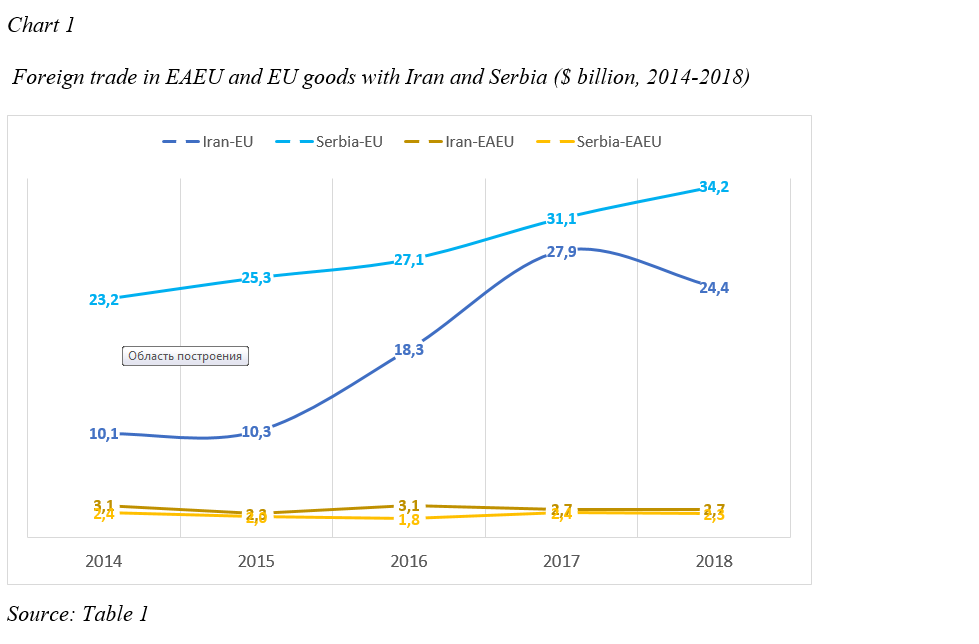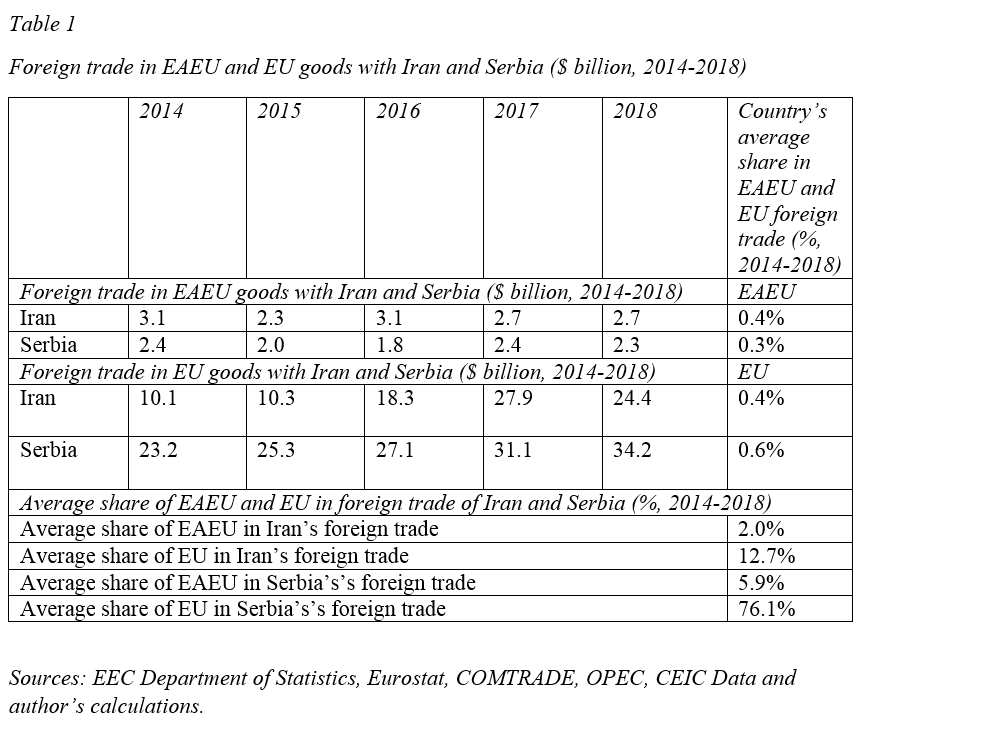A Win-Win Situation: EAEU Signs Free Trade Deals with Serbia and Iran
October 29, 2019
0
comments
2284
Views
Add to reader
Print
In
Log in if you are already registered
_ Yuri Kofner, research assistant, IIASA; non-residential research fellow, Skolkovo Institute for Emerging Market Studies; editor-in-chief, analytical media "Eurasian Studies". First publication on: "Valdai" International Discussion Club. Munich, 29 October 2019.* On October 25 in Moscow, prime ministers of the Eurasian Economic Union (EAEU) member states, Chairman of the Eurasian Economic Commission (EEC) Tigran Sargsyan and Prime Minister of Serbia Ana Brnabic signed a Free Trade Agreement between Serbia and the EAEU. On October 27, a “temporary” free trade zone was launched between Iran and the EAEU.
Serbia’s decision to conclude a free trade zone agreement with the Eurasian Economic Union was bad news for the European Commission, which had warned Serbia over making that decision several times. There are several reasons for Europe’s grudge. And given that Serbia accounts for less than 1 percent of the EU’s foreign trade (Table 1)(1) , they are obviously geopolitical. Firstly, Brussels has always been uncomfortable when it comes to the special friendship between Moscow and Belgrade, as they have been counting on Belgrade’s “gradual alignment with the common EU foreign and defense policies” as part of European integration. However, this naughty junior partner declined to join the European sanctions against the “eastern aggressor,” and worse still, decided to sign a new preferential trade deal with that aggressor. Secondly, on the day when it is supposed to become a member of the EU, which is formally slated for the year 2025, Serbia will be obliged to cancel all its previous bilateral trade agreements with any third parties. However, there is no real guarantee that this day will ever really come, whether it be 2025 or some other year. Serbia is unlikely to have thrown aside the lessons it learned from its neighbors Northern Macedonia and Albania and their experience. Both these countries have been striving to become part of the European family for the last five and 10 years, respectively, only to get their accession vetoed from the European Council just last week. Thirdly, Europe behaves this way because it still has not grown out of its good old Eurocentrism and is not ready to accept that the 15-year belle epoque, when it was the only point of gravity in the wider Eurasian space, has given way to a multipolarity era with emerging rival gravity centers such as China and the EAEU. In this context what it needs to do is move away from the zero-sum game and its own exclusiveness mentality towards the logic of inclusive economic cooperation “from Lisbon to Shanghai.”
The rise of Eurasia?
Serbia’s decision to conclude a free trade zone agreement with the Eurasian Economic Union was bad news for the European Commission, which had warned Serbia over making that decision several times. There are several reasons for Europe’s grudge. And given that Serbia accounts for less than 1 percent of the EU’s foreign trade (Table 1)(1) , they are obviously geopolitical. Firstly, Brussels has always been uncomfortable when it comes to the special friendship between Moscow and Belgrade, as they have been counting on Belgrade’s “gradual alignment with the common EU foreign and defense policies” as part of European integration. However, this naughty junior partner declined to join the European sanctions against the “eastern aggressor,” and worse still, decided to sign a new preferential trade deal with that aggressor. Secondly, on the day when it is supposed to become a member of the EU, which is formally slated for the year 2025, Serbia will be obliged to cancel all its previous bilateral trade agreements with any third parties. However, there is no real guarantee that this day will ever really come, whether it be 2025 or some other year. Serbia is unlikely to have thrown aside the lessons it learned from its neighbors Northern Macedonia and Albania and their experience. Both these countries have been striving to become part of the European family for the last five and 10 years, respectively, only to get their accession vetoed from the European Council just last week. Thirdly, Europe behaves this way because it still has not grown out of its good old Eurocentrism and is not ready to accept that the 15-year belle epoque, when it was the only point of gravity in the wider Eurasian space, has given way to a multipolarity era with emerging rival gravity centers such as China and the EAEU. In this context what it needs to do is move away from the zero-sum game and its own exclusiveness mentality towards the logic of inclusive economic cooperation “from Lisbon to Shanghai.”
 To be fair, I must say that both Serbia and Iran account for only a small share in the foreign trade structure of the EAEU: 0.4 percent and 0.3 percent, respectively. Similarly, for these two countries, trade with the EU is far more important than that with the EAEU. The EU’s share in Serbia's foreign trade is 76.1 percent, while the EAEU only accounts for about 6 percent. Almost 13 percent of Iran’s foreign trade is with the EU, and only 2 percent with the EAEU. (Chart 1, Table 1)
To be fair, I must say that both Serbia and Iran account for only a small share in the foreign trade structure of the EAEU: 0.4 percent and 0.3 percent, respectively. Similarly, for these two countries, trade with the EU is far more important than that with the EAEU. The EU’s share in Serbia's foreign trade is 76.1 percent, while the EAEU only accounts for about 6 percent. Almost 13 percent of Iran’s foreign trade is with the EU, and only 2 percent with the EAEU. (Chart 1, Table 1) Free trade 101
In theory, each party to a free trade deal has two goals. On the one hand, with zero or lower import duties we open new market niches for our manufacturers’ goods (greater demand). On the other hand, opening our market in the same way, we get less expensive and better products for domestic consumption (greater supply). According to David Ricardo’s theory, cumulative welfare should grow on both sides. At the same time, there is no need to open markets with each other symmetrically. In international practice, it is often done asymmetrically, in terms of time, when the parties are given phasing-in periods, as well as for individual product groups. This is the case with the EAEU’s free trade deals with Serbia and Iran.
Serbia has individual agreements with three out of the five EAEU members – Russia, Belarus and Kazakhstan. But a general free trade deal should harmonize the conditions for all parties in accessing the Serbian market and additionally provide Armenia and Kyrgyzstan with a preferential opportunity to enter that market.
In particular, tariff preferences will enable EAEU manufacturers to increase their exports of food, strong liquor, cigarettes, and a variety of industrial products such as components for motor vehicles, chemical fertilizers, and electronic equipment. On the other hand, the agreement provides for a duty-free import of 99.5 percent of goods produced in Serbia into the EAEU. This means that a few years after the deal, Serbia’s exports to a common market of 184 million people can increase by another 15 percent or so above the agreement-free scenario. Basically, the EAEU will open its market by reducing import duties for Serbian farm produce such as cheese, tobacco and local brandy (Rakia).
At the same time, the EAEU will not extend trade preferences to poultry meat, sugar, fabrics, plus to a number of industrial goods including compressors and motor vehicles. According to experts, Russia will keep its protectionist policies to protect its auto industry from the possible competition of the Serbian Fiat.
As for Iran, given the unstable international situation, the unknown business environment and the overlapping economic structure, the EEC and the individual EAEU governments have for the time being decided to opt for an interim agreement “leading to the formation of a free trade zone” – a three-year trial version, one might say. It covers only half of the commodity range and does not extend preferences to goods like crude oil or refined products.
In exchange, the EAEU will receive preferences for the supply of meat and fat-foods, various sorts of confectionery and chocolate, as well as metals, cosmetics, and things like electronic and mechanical goods. In particular, the arrangement will benefit Eurasian producers of environmentally friendly halal produce, rolled steel and telecom equipment, which over the past three years have become the EAEU's main export products to the Iranian market. In turn, the Iranian side will be provided with tariff preferences for an expanded list of food, primarily vegetables, fruit, dried fruit, as well as building materials, utensils, some non-ferrous metal products and, most importantly, the famous Persian rugs.
For industrial goods, the average level of import duties in Iran will go down from 22.4 percent to 15.4 percent; in EAEU, from 8 percent to 4.7 percent. For farm produce, Iran will reduce duties on average from 32.2 percent to 13.2 percent, or by 19 ppt; the EAEU, from 9.6 percent to 4.6 percent. In the future, trade between Iran and the EAEU may grow by as much as 50 percent.
The EAEU-Serbia and EAEU-Iran free trade agreements provide for a number of other advantages in addition to the direct reduction of import duties. Firstly, neither Serbia nor Iran are members of the World Trade Organization (WTO), yet, under the deals, both agree to grant EAEU goods “basic” conditions based on the WTO rules, especially as regards applying protective measures, permission disputes and rules of origin. Thirdly, small Armenia should especially benefit from the access to the 83-million-strong Iranian market – it can become a transport and logistics hub on the North-South international transport corridor, and its Meghri Free Economic Zone, an interesting platform for the assembly of European, Eurasian and Iranian companies’ products with the subsequent foray into the latter two markets. Fourthly, transparent and preferential trade terms should contribute to stability on the markets, which naturally enhances the confidence of entrepreneurs, and consequently, creates a favorable environment for investments.
In order to support their industry, developed countries, as a rule, levy a zero duty on imports of primary raw materials and energy carriers. Therefore, developing economies, which are dependent on exports of this basic category of goods, such as the EAEU countries, should be interested not so much in further lowering tariffs, which are already low or absent, but more in creating a legal framework to attract foreign investment and technologies that promote their own catching-up modernization. This is despite the fact that in the global post-industrial economy the main added value is no longer created in the manufacturing sector, but in trade with services, knowledge and “digits”. And a related, but no less important issue remains the means of payment for goods delivered under the FTZ. In conditions when the US dollar is increasingly becoming an instrument of Washington’s sanctions policy, the need arises for the de-dolllarization of mutual trade and the transition to other payment currencies, for example, the ruble, yuan and euro. The difficulty is that the Eurasian Economic Commission does not have enough authority to conduct negotiations in these key areas. The governments of the EAEU member states have only two ways out of this situation: firstly, they could “upgrade” the Union Treaty and delegate the necessary powers to the EEC. Otherwise, secondly, they could add to the existing multilateral “horizontal” preferental trade agreements “vertical” bilateral agreements (for example, along the lines of Armenia-Iran, Belarus-Iran, Kazakhstan-Iran, etc.), which would stipulate a mutual liberalization of various service sectors, investment guarantees, industrial corporation mechanisms, e-commerce rules, intellectual property protection, and so on. This is precisely the meaning and relevance of the EAEU - Singapore free trade agreement and the EAEU - Singapore Framework Agreement on Comprehensive Economic Cooperation, both signed on 1 October 2019 in Yerevan. It would be good, if the EAEU would supplement the FTA agreements with Serbia and Iran, as well as the non-preferential agreement on trade and economic cooperation with China [2], which also entered into force on October 25, according to the above mentioned logic. By the way, many Eurasian experts have opposed Beijing's proposal to create a free trade zone with the EAEU, believing that Eurasian producers will not be able to compete with their Chinese counterparts. But why not give one another preferential terms for a short and asymmetric list of goods? They say, for example, that the Chinese are very fond of ice cream “made in the EAEU”. Notes: * The views expressed in the article are solely that of the author and may not represent that of Skolkovo or IIASA. Source: http://valdaiclub.com/
* The views expressed in the article are solely that of the author and may not represent that of Skolkovo or IIASA. Source: http://valdaiclub.com/
The future of world trade
In order to support their industry, developed countries, as a rule, levy a zero duty on imports of primary raw materials and energy carriers. Therefore, developing economies, which are dependent on exports of this basic category of goods, such as the EAEU countries, should be interested not so much in further lowering tariffs, which are already low or absent, but more in creating a legal framework to attract foreign investment and technologies that promote their own catching-up modernization. This is despite the fact that in the global post-industrial economy the main added value is no longer created in the manufacturing sector, but in trade with services, knowledge and “digits”. And a related, but no less important issue remains the means of payment for goods delivered under the FTZ. In conditions when the US dollar is increasingly becoming an instrument of Washington’s sanctions policy, the need arises for the de-dolllarization of mutual trade and the transition to other payment currencies, for example, the ruble, yuan and euro. The difficulty is that the Eurasian Economic Commission does not have enough authority to conduct negotiations in these key areas. The governments of the EAEU member states have only two ways out of this situation: firstly, they could “upgrade” the Union Treaty and delegate the necessary powers to the EEC. Otherwise, secondly, they could add to the existing multilateral “horizontal” preferental trade agreements “vertical” bilateral agreements (for example, along the lines of Armenia-Iran, Belarus-Iran, Kazakhstan-Iran, etc.), which would stipulate a mutual liberalization of various service sectors, investment guarantees, industrial corporation mechanisms, e-commerce rules, intellectual property protection, and so on. This is precisely the meaning and relevance of the EAEU - Singapore free trade agreement and the EAEU - Singapore Framework Agreement on Comprehensive Economic Cooperation, both signed on 1 October 2019 in Yerevan. It would be good, if the EAEU would supplement the FTA agreements with Serbia and Iran, as well as the non-preferential agreement on trade and economic cooperation with China [2], which also entered into force on October 25, according to the above mentioned logic. By the way, many Eurasian experts have opposed Beijing's proposal to create a free trade zone with the EAEU, believing that Eurasian producers will not be able to compete with their Chinese counterparts. But why not give one another preferential terms for a short and asymmetric list of goods? They say, for example, that the Chinese are very fond of ice cream “made in the EAEU”. Notes:
- Hereinafter, foreign trade shares taken as 2014 -2018 average.
 * The views expressed in the article are solely that of the author and may not represent that of Skolkovo or IIASA. Source: http://valdaiclub.com/
* The views expressed in the article are solely that of the author and may not represent that of Skolkovo or IIASA. Source: http://valdaiclub.com/ Share this article
OTHER RECORDS
Trade and welfare effects of implementing the Belarus-Russia Union State
January 23, 2021
Yuri Kofner
Economic effects of Ukraine-EU DCFTA and of counterfactual integration with the Eurasian Economic Union
January 12, 2021
Yuri Kofner
Back to the future: German industrial Ordnungspolitik
December 13, 2020
Yuri Kofner




